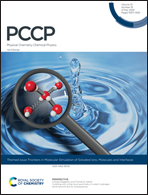Identifying the role of excess electrons and holes for initiating the photocatalytic dissociation of methanol on a TiO2(110) surface†
Abstract
As a prototype for the catalytic oxidation of organic contaminants, photocatalytic methanol dissociation on rutile TiO2(110) has drawn much attention, but its reaction mechanism remains elusive. While polarons are ubiquitous in photovoltaics and heterogeneous catalysis, how surface polarons influence adsorption remains unclear. In this paper, density functional theory is used to study the effect of excess electrons and holes on methanol dissociation on rutile TiO2(110). The effect of excess carriers for three types of methanol dissociation on the metal oxides are compared. The results show that the excess electron and hole play different roles in the dissociation reactions even though they present similar adsorption behaviors. The excess electron is easily trapped in the lattice Ti atom, and it decreases the dissociation barrier of methanol to 0.13 eV. Furthermore, the excess hole prefers to stick with the hydroxyl radical, which increases the energy barrier of methanol dissociation up to 0.43 eV. It was found that the height of the dissociation barrier is dependent on the orientation of the methanol molecules, not on the distance to the modified electron. This study identifies the essential roles of excess electrons and holes for promoting O–H dissociation. Our findings contribute considerably to broadening the understanding of photocatalytic chemistry.



 Please wait while we load your content...
Please wait while we load your content...